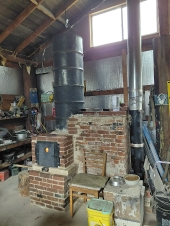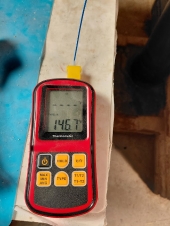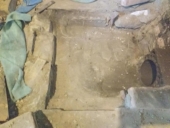


Jackson Bradley wrote:I get somewhat confused on the longevity of the different parts for the different types.
I can't quite wrap my head around what I'll need to replace/clean, about how often it will need replaced. That seems to depend on the type of RMH. I have read through your masonry build in the large building, the Wisner's materials, Thomas Rubino's projects, etc. I have seen where some of the metal components need to be replaced and some of the bricks crack and need replaced, etc.
I understand a factor of that would be climate dependent due to the amount it would be used (wood burned). The larger masonry heaters seem like what I would work up to in my residence but practice building one on in my accessory building.


Glenn Herbert wrote:I agree that a ducted mass would continuously lose heat with any amount of residual draft. I think a stratification chamber would be more dependent on details of the configuration. If the combustion core exit (riser top or secondary chamber exit port) is near the top of the stratification chamber, then it will be introducing cooler air and diluting all the stratified hot air remaining. If the core exit is low in the stratification chamber, it can move more directly to the chimney exit and leave the hot upper part of the chamber undisturbed. This is assuming that draft is restricted from full burn-time flow and does not "jet" at all.



Matt Todd wrote:
thomas rubino wrote:
I am very happy to report the highest temps my arch has risen to are just over 400F!!! (Success!)
Do you have any measurement on what your core exhaust temperature is reading?
Reason I ask is, I'M BUILDING A SHORTY IN A BRICK BELL TOO!
One final detail I'm working out is the internal chimney. Planning to do the "plunger tube" style of chimney into the bell. But my Shorty core will flip the exhaust to shoot out the back wall of the riser stub so I can put an oven on top of the firebox. The potential issue being hot exhaust shooting horizontally right at my plunger tube. My DSR2 build has a black stove pipe plunger tube and I intend to do the same here. Just a little worried about it being directly in the exhaust path.

Cerbu Ulea wrote:2 tons I think its a fair guess, fire bricks seam heavier , 3 kilos each? some in the top bell plus the core , the sand was say 10 buckets, and the old terracotta tiles count I think, is it a good number? It stays warm 36 + hours this time of year, but one fire a day I prefer now

Cerbu Ulea wrote:please help me calculate the mass of my stove , single skin yet, it has aprox. 400 bricks at about 2,7 kilos each , the core has thin mortar but in the bell's walls there is a lot of clay & sand , add also the number of the fire brick in the core , which I did not weigh
